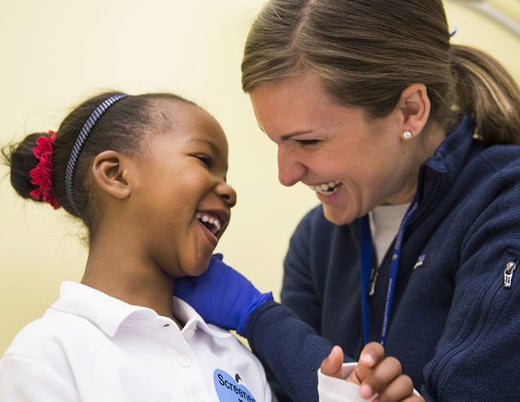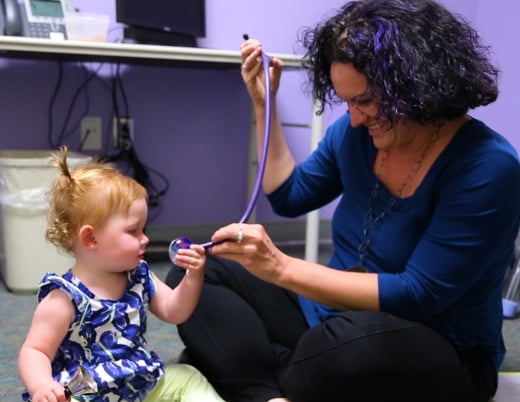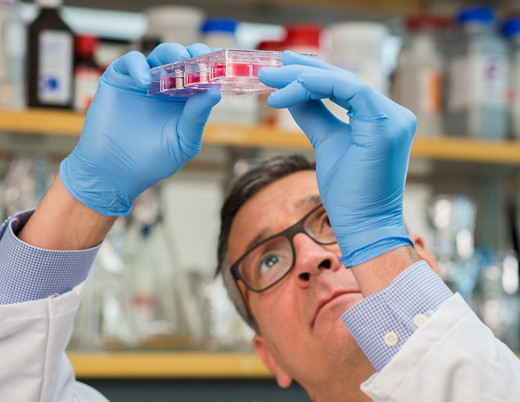Can a new protein target improve the durability of CAR T-cell therapies?
Approved by the FDA in 2017, tisagenlecleucel is a genetically engineered product that forces a patient’s own T-cells to destroy acute lymphoblastic leukemia, or ALL. These chimeric antigen receptor cells, or CAR T-cells, work by targeting CD19, a surface protein most ALL cells express. The problem is that, in about half of relapsed cases, ALL cells mutate to lose CD19, leaving the CAR T-cells nothing to attach to. One potential solution is a CAR T-cell product that can seek another surface protein, CD22. Researchers at Children’s Hospital Colorado and the Gates Biomanufacturing Facility on the Anschutz Medical Campus are currently manufacturing a product that can target both proteins – and the clinical trial is enrolling.
Onsite CAR T-cell biomanufacturing: “a huge advantage”
From the initial blood draw obtaining a patient’s T cells to treatment with tisagenlecleucel, turnaround is about six weeks.
“But when someone has active acute leukemia, you don’t want to hang around six weeks to see what might happen,” says pediatric hematologist-oncologist Amy Keating, MD. “You want to treat that as quickly as possible.”
That was part of the impetus for campus-wide investment in onsite CAR T-cell biomanufacturing, a program that kicked off in earnest on the Anschutz Medical Campus in 2016. Children’s Colorado currently has several patients enrolled in phase one clinical trials for its in-house CD19 product. Turnaround is about two weeks.
“That’s a huge advantage for those patients,” says Dr. Keating.
It’s not the only advantage of onsite biomanufacturing infrastructure. As a medical treatment, chimeric antigen receptor technology is still in its infancy. With the tools to conceive and build novel CARs, Children’s Colorado researchers are well positioned to begin the long task of solving for CAR therapy’s significant limitations – and to harness its extravagant potential.
CAR T-cells with a dual attack
From the beginning, it was clear the CD19 CAR would not be a perfect solution. An initial remission rate of 89% dropped by half within a year of treatment, as leukemic cells mutated or CAR T-cells died off. Researchers at the National Institutes of Health initially developed the CD22-targeted CAR for patients who had already relapsed after CD19 therapy.
“Now, the thinking is that a leukemia cell might just happen to lose that one protein,” Dr. Keating says. “But it’s hard to get struck by lightning twice.”
Currently, three pediatric centers around the globe are working on CAR T-cell products with a dual attack, targeting CD19 and 22 simultaneously. Children’s Colorado is one of them, and the FDA has given the team’s CD19/22 CAR a greenlight to start with phase one clinical trials in adults, which will take place at neighboring UCHealth on the Anschutz Campus. That trial is currently enrolling. It will open to pediatric patients at Children’s Colorado soon.
Targeting a wider range of cancers
Dr. Keating is just one of many researchers working to advance CAR therapy within Children’s Colorado’s Center for Cancer and Blood Disorders. Others are participating in open trials for CAR cells that target CD33 and CD123, surface proteins of acute myeloid leukemia. At the bench, still more are working on getting CARs into solid tumors and brain tumors.
For Dr. Keating’s team, the next priority, among many, will be to move CAR therapy toward the front lines of care.
“It’s a tough call, because the cure rate for traditional chemotherapy for most ALL patients is 90%,” she says. “That’s hard to walk away from.”
But chemotherapy is also a much longer and more arduous course of treatment – two years as opposed to three or four months. Dr. Keating was a part of the research team that helped validate tisagenlecleucel in real-world application (1), and she’s part of the Children’s Colorado team that’s currently enrolling to a Children’s Oncology Group trial to test it as a front-line therapy for some high-risk ALL patients. She’s also working on using CAR therapy to treat a larger fraction of ALL and non-Hodgkin lymphoma patients who would otherwise be destined for bone marrow transplant, a significantly steeper burden of care.
It’s an exciting frontier.
“Being able to utilize the immune system to fight disease, it’s just fun,” she says. “It’s the coolest organ in the whole body.”
Featured Researchers
Amy Keating, MD
Pediatric hematologist-oncologist
Center for Cancer and Blood Disorders
Children's Hospital Colorado
Associate professor
Pediatrics-Hematology/Oncology
University of Colorado School of Medicine





 720-777-0123
720-777-0123










